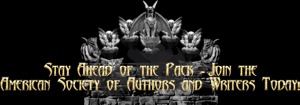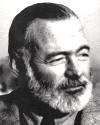 On July
21, 1899, all of American literature was about to change. It's on that
date that novelist Ernest Hemingway was born in Chicago's suburban Oak
Park, Illinois. As a writer, he would give the world some of its most
popular novels, including The Sun Also Rises (1926), A Farewell to Arms (1929), For Whom the Bell Tolls
(1940),
and The Old Man and the Sea (1952).
In time, he grew to become one of the most
influential writers in the world and one of the first popular American
writers to be taken seriously by the world press.
On July
21, 1899, all of American literature was about to change. It's on that
date that novelist Ernest Hemingway was born in Chicago's suburban Oak
Park, Illinois. As a writer, he would give the world some of its most
popular novels, including The Sun Also Rises (1926), A Farewell to Arms (1929), For Whom the Bell Tolls
(1940),
and The Old Man and the Sea (1952).
In time, he grew to become one of the most
influential writers in the world and one of the first popular American
writers to be taken seriously by the world press.
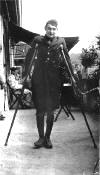 Rejected
by the U.S. army during World War I for his poor eyesight (which he later
erroneously claimed was due to boxing), Hemingway's determination to join the
war effort landed him a post with the Red Cross as an ambulance driver on
the Italian front. At 17, he jumped at the chance to be a
canteen-provider on the front lines, handing out chocolate and cigarettes to
the troops during battle.
Rejected
by the U.S. army during World War I for his poor eyesight (which he later
erroneously claimed was due to boxing), Hemingway's determination to join the
war effort landed him a post with the Red Cross as an ambulance driver on
the Italian front. At 17, he jumped at the chance to be a
canteen-provider on the front lines, handing out chocolate and cigarettes to
the troops during battle.
On July 8, 1918, he was hit in the leg by an
Austrian mortar shell. Despite the wound, he managed to carry an
Italian soldier to a nearby command post. Machine-gun fire
struck him in the knee and foot, and he was eventually sent to a hospital in
Milan, Italy, before returning to the family home in Oak Park.
Hemingway had always wanted to be a writer. He wrote a few short
stories while he was recovering from his wounds, but he was frustrated that
he wasn't able to convey the intensity of his emotions about the war.
He spent weeks lying around his parents' house, reading and talking to his
sisters. He was one of the first American soldiers to return from
Italy, which made him something of a local celebrity. He
spoke publicly about the war in places such as Oak Park High School. Although his parents encouraged him to leave home to attend
the University of Wisconsin, Hemingway said that he had received all the
education he needed in the war.
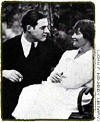 In
1920, when he was twenty years old, he began writing stories for
several Chicago newspapers and magazines. He became acquainted with
writer Sherwood Anderson, who told him that if he was serious about
becoming a novelist, he needed to move to Paris and live among the expatriate
writers there. Hemingway offered to become a foreign correspondent for
the Toronto Daily Star, to be paid by the word. They agreed,
and Hemingway and his new wealthy socialite wife, Hadley Richardson, were soon
on a boat to Europe, carrying letters of introduction to the likes of Gertrude
Stein and Ford Madox Ford.
In
1920, when he was twenty years old, he began writing stories for
several Chicago newspapers and magazines. He became acquainted with
writer Sherwood Anderson, who told him that if he was serious about
becoming a novelist, he needed to move to Paris and live among the expatriate
writers there. Hemingway offered to become a foreign correspondent for
the Toronto Daily Star, to be paid by the word. They agreed,
and Hemingway and his new wealthy socialite wife, Hadley Richardson, were soon
on a boat to Europe, carrying letters of introduction to the likes of Gertrude
Stein and Ford Madox Ford.
The couple moved into an apartment in the Latin Quarter in
a neighborhood filled with drunks, beggars, and street musicians. Rent was
250 francs a month, or about eighteen dollars. He wrote to his friend,
writer John Dos Passos, "[My apartment] is on top of a tall hill in the
oldest part of Paris and directly above a fine place called the Bal du
printemps .... The noise of the accordion they dance to you can hear if
you listen for it, but it doesn't intrude." Hemingway liked to give
the impression that he was a Bohemian, struggling just to get by, although,
thanks to his wife, he
actually had plenty of money. The couple could afford to travel
around Europe, go to the horse races, and eat dinner at nice restaurants.
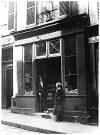 Paris
in the Twenties was filled with famous expatriate American and British
writers, including Ezra Pound, Gertrude Stein, F. Scott Fitzgerald, James
Joyce, and Ford Madox Ford. Hemingway often met with them at Sylvia
Beach's English-language bookstore, Shakespeare and Company, or over tea at
Gertrude Stein's home. His friend, Gerald Murphy, called Hemingway "an
enveloping personality, so physically huge and forceful, and he overstated
everything and talked so rapidly and so graphically and so well that you
found yourself agreeing with him."
Paris
in the Twenties was filled with famous expatriate American and British
writers, including Ezra Pound, Gertrude Stein, F. Scott Fitzgerald, James
Joyce, and Ford Madox Ford. Hemingway often met with them at Sylvia
Beach's English-language bookstore, Shakespeare and Company, or over tea at
Gertrude Stein's home. His friend, Gerald Murphy, called Hemingway "an
enveloping personality, so physically huge and forceful, and he overstated
everything and talked so rapidly and so graphically and so well that you
found yourself agreeing with him."
Writing every day, Hemingway gradually perfecting his literary style, following his
motto, "All you have to do is write one true sentence. Write the
truest sentence you know." Sometimes he wrote in his apartment and
sometimes in the local cafés. He wrote in a letter to his father: "I'm
trying in all my stories to get the feeling of the actual life across—not to
just depict life—or criticize it—but to actually make it alive. So that when
you have read something by me you actually experience the thing. You
can't do this without putting in the bad and the ugly as well as what is
beautiful. Because if it is all beautiful you can't believe in it.
Things aren't that way. It is only by showing both sides—3 dimensions
and if possible 4 that you can write the way I want to."
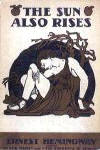 In
1925, he took a trip to Spain and published a collection of short stories
called In Our Time.
Although the book stirred little positive commentary, the trip served as the inspiration for
his first big success, The Sun Also Rises
(1926), about a group of
Americans living hedonistic, directionless lives in Europe. It was
based on Hemingway's own life, and it chronicled a group of American
expatriates who travel from Paris to Pamplona, Spain, for the Running of the
Bulls. In one of the epigraphs to the novel, he quoted Gertrude
Stein: "You are all a lost generation," and Hemingway became known as the
leading spokesman for the disillusioned post-World War I generation.
In
1925, he took a trip to Spain and published a collection of short stories
called In Our Time.
Although the book stirred little positive commentary, the trip served as the inspiration for
his first big success, The Sun Also Rises
(1926), about a group of
Americans living hedonistic, directionless lives in Europe. It was
based on Hemingway's own life, and it chronicled a group of American
expatriates who travel from Paris to Pamplona, Spain, for the Running of the
Bulls. In one of the epigraphs to the novel, he quoted Gertrude
Stein: "You are all a lost generation," and Hemingway became known as the
leading spokesman for the disillusioned post-World War I generation.
With the publication of his novel, Hemingway's life would
never be the same. The book was an international success. But,
just as his literary career was taking off, his personal life was beginning
to show some cracks. He had begun an affair with Pauline Pfeiffer, a
close friend of both Hadley and he. The following year, Hadley
divorced Hemingway, who promptly took his second wife.
Hemingway had also begun cutting his ties with the Paris group that
had helped
him so much. "I think Hemingway had some significant strengths as a writer and
human being, but he also had profound weaknesses," said Hemingway scholar
Dr. James Nagel. "One of his weaknesses is that he seems not to have
been very good at feeling gratitude. He tended to turn his back on
people who helped him."
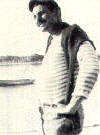 Hemingway
and Pauline moved to Key West, where he attempted to build on his
reputation as one of America's preeminent writers with A Farewell to Arms.
Part way through the book, he received word that his father, Clarence, who
had been battling depression and health problems, died of a self-inflicted
gunshot wound to the head on December 6, 1928.
Hemingway
and Pauline moved to Key West, where he attempted to build on his
reputation as one of America's preeminent writers with A Farewell to Arms.
Part way through the book, he received word that his father, Clarence, who
had been battling depression and health problems, died of a self-inflicted
gunshot wound to the head on December 6, 1928.
In a letter to Max Perkins, his Scribner's editor, he
wrote: "I was very fond of him and feel like hell about it. Got to Oak
Park in plenty of time to handle things ... Realize of course that the thing
for me to do is not worry but get to work--finish my book properly so I can
help them out with the proceeds."
By the time A Farewell to Arms
was released
the
following year, Hemingway had become one of the best-known writers alive. Strangers
approached him at cafés. Young American men emulated him, speaking in
staccato sentences from the sides of their mouths.
 In
1933, Hemingway fulfilled a lifelong dream when he and Pauline went on a
hunting safari in
Africa, where they bagged several lions and other trophy game.
The trip had been a gift from Pauline's uncle, and it would ultimately lead
to several stories, including one of Hemingway's best short pieces, The Snows of Kilimanjaro.
In 1935, Hemingway recounted his safari experiences
in The Green Hills of Africa, adding to his legend as a
writer-adventurer.
In
1933, Hemingway fulfilled a lifelong dream when he and Pauline went on a
hunting safari in
Africa, where they bagged several lions and other trophy game.
The trip had been a gift from Pauline's uncle, and it would ultimately lead
to several stories, including one of Hemingway's best short pieces, The Snows of Kilimanjaro.
In 1935, Hemingway recounted his safari experiences
in The Green Hills of Africa, adding to his legend as a
writer-adventurer.
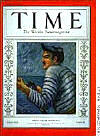 In
1937, Hemingway traveled overseas as a correspondent to cover the Spanish
Civil War. The country was divided by the conflict, and Hemingway's
reporting was well received in the States. To many, he had become the
ultimate
celebrity reporter, the veteran of war, the heroic adventurer seeking his
next thrill.
In
1937, Hemingway traveled overseas as a correspondent to cover the Spanish
Civil War. The country was divided by the conflict, and Hemingway's
reporting was well received in the States. To many, he had become the
ultimate
celebrity reporter, the veteran of war, the heroic adventurer seeking his
next thrill.
Hemingway had company on his trip to Spain, his new
love, Martha Gellhorn, a reporter he had met in 1936 in Key West.
The author divorced Pauline in 1940 and married Gellhorn, and the two moved to
a house on a large tract of land in San Francisco de Paula, Cuba. They
named the estate La Finca Vigia.
In 1952, when Life magazine published The Old Man and the Sea
complete in a single issue, it sold more than five million
copies in two days.
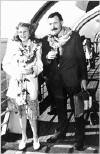 But
at the height of his literary success, Hemingway was growing increasingly
paranoid. He was convinced that someone was trying to kill him.
In a telephone conversation with A. E. Hotchner, a friend and editor, Hotchner recalled the first time he ever heard Hemingway sound unsure of
himself. He had always been master of his own destiny, especially on
issues relating to his writing: content, style, and publishing details.
He was working on The Dangerous Summer.
His dilemma was how to cut
his 92,453 words down to 40,000 for Life Magazine, as his contract
stipulated. He complained to Hotchner of having nightmares about
it. He was also concerned about his eyes, which he said doctors
had diagnosed as afflicted by keratis sicca, a condition that causes the cornea to
dry up.
But
at the height of his literary success, Hemingway was growing increasingly
paranoid. He was convinced that someone was trying to kill him.
In a telephone conversation with A. E. Hotchner, a friend and editor, Hotchner recalled the first time he ever heard Hemingway sound unsure of
himself. He had always been master of his own destiny, especially on
issues relating to his writing: content, style, and publishing details.
He was working on The Dangerous Summer.
His dilemma was how to cut
his 92,453 words down to 40,000 for Life Magazine, as his contract
stipulated. He complained to Hotchner of having nightmares about
it. He was also concerned about his eyes, which he said doctors
had diagnosed as afflicted by keratis sicca, a condition that causes the cornea to
dry up.
Hotchner attributed the author’s growing insecurities to
his eye problems, the stress from editing his Life Magazine piece, and news about Gary
Cooper, a close friend. Cooper had to have a prostrate operation, and
Hemingway was upset about it, as the two men had become close friends.
 When
Hotchner visited the Hemingways in Havana, he convinced the author to let
him give the manuscript of The Dangerous Summer
to Life Magazine.
It was by now cut down to 53,830 words. Hemingway confessed that he
felt like he was “living in a Kafka nightmare” and that, although he acted
happy, he was “bone-tired and very beat up emotionally.” He related
that, with Castro's guerillas marching on the capital, he and Mary would
have to leave the Finca. He came to that conclusion the night his dog was clubbed
to death by a Batista search party. Hemingway had loved the dog, just
as he did La Finca, his art collection, his study, his boat, and his
memories associated with Cuba. Suddenly, he was forced to abandon
all.
When
Hotchner visited the Hemingways in Havana, he convinced the author to let
him give the manuscript of The Dangerous Summer
to Life Magazine.
It was by now cut down to 53,830 words. Hemingway confessed that he
felt like he was “living in a Kafka nightmare” and that, although he acted
happy, he was “bone-tired and very beat up emotionally.” He related
that, with Castro's guerillas marching on the capital, he and Mary would
have to leave the Finca. He came to that conclusion the night his dog was clubbed
to death by a Batista search party. Hemingway had loved the dog, just
as he did La Finca, his art collection, his study, his boat, and his
memories associated with Cuba. Suddenly, he was forced to abandon
all.
One evening, as Hemingway ate at a restaurant with friends,
he grabbed the waiter by the sleeve and began shouting at him,
demanding to know whether he was Spanish or Polish. When the waiter
told him that he was Polish, Hemingway screamed all the louder.
 Hemingway's
delusions continued to grow after he moved with his new wife, Mary Welsh, from Cuba to a
mountain retreat in Ketchum, Idaho. The writer was convinced that J.
Edgar Hoover and the Feds were after him. He told Hotchner that they
had cars following him on the road and that his phone was tapped.
Once, when he was out with friends, he demanded that they leave because two
men sitting at the bar were FBI agents following him. They turned out
to be traveling salesmen.
Hemingway's
delusions continued to grow after he moved with his new wife, Mary Welsh, from Cuba to a
mountain retreat in Ketchum, Idaho. The writer was convinced that J.
Edgar Hoover and the Feds were after him. He told Hotchner that they
had cars following him on the road and that his phone was tapped.
Once, when he was out with friends, he demanded that they leave because two
men sitting at the bar were FBI agents following him. They turned out
to be traveling salesmen.
Hemingway's condition deteriorated. While working on
a manuscript, he found for the first time in his life that he could no
longer write. That
was the final blow to his abilities as a man and as a writer, the two being
intertwined. On Sunday morning, April 18, at 11:00 a.m., Mary found
him standing with a gun in one hand and shells in the other. There was
a note to her propped up on the gun rack. She distracted him long
enough for Vernon, his doctor, to arrive. Hemingway gave up the gun
without a struggle.
Vernon confided to Hotchner about Hemingway’s condition:
“Hotch, honest to God, if we don’t get him to the proper place, and fast, he
is going to kill himself for sure. It’s only a question of time if he
stays here, and every hour it grows more possible. He says he can’t
write any more—that’s all he’s talked to me about for weeks and weeks.
Says there’s nothing to live for. Hotch, he won’t ever write again.
He can’t. He’s given up. That’s the motivation for doing away with
himself.”
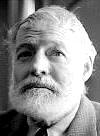 Hemingway
was admitted to the Mayo clinic, where he endured electroconvulsive shock
treatment prescribed for severely depressed patients. Irvin D. Yalom,
psychiatrist at Stanford University School of Medicine, stated that
Hemingway struggled all his life with severe characterologic problems.
By 1960, the signs of severe depression had become evident: anorexia, severe
weight loss, insomnia, deep sadness, total pessimism, and self-destructive
trends.
Hemingway
was admitted to the Mayo clinic, where he endured electroconvulsive shock
treatment prescribed for severely depressed patients. Irvin D. Yalom,
psychiatrist at Stanford University School of Medicine, stated that
Hemingway struggled all his life with severe characterologic problems.
By 1960, the signs of severe depression had become evident: anorexia, severe
weight loss, insomnia, deep sadness, total pessimism, and self-destructive
trends.
The shock treatments he received were known to be
ineffectual when strong paranoid symptoms accompanied the depression.
Hemingway complained that the treatments had destroyed his memory and his
ability to write. They were stopped in the middle of the cycle, and
Hemingway returned home to Ketchum. It was there that he finally
fulfilled his grand plan. He woke up on the morning of July 2, 1961,
climbed out of bed, and took his own life.
John Hemingway, Ernest’s son, remembered a time when his
father had warned him after he had become depressed about his termination
from the army: “You must promise me never, never ... we’ll both promise each
other never to shoot ourselves. Don’t do it. It’s stupid. It’s
one thing you must promise me never to do, and I’ll promise the same to
you.”
Perhaps most fortuitous of all was the short story he had
written in
1924, where a man put a gun in his mouth and pulled the trigger with his
toe, blowing the top of his head off. Hemingway died with his favorite shotgun lodged between his
teeth...and the top of his head blown off.
 In
all, five out of six generations of Hemingways have experienced the loss of
at least one family member to suicide. Besides Hemingway and his
father, they include a brother, a sister, and the author's granddaughter,
supermodel and Playboy centerfold, Margaux. In the single
generation that was skipped, Hemingway's son, Gregory, a cross-dresser and
transsexual with a long history of severe depression, died of suspicious
causes.
In
all, five out of six generations of Hemingways have experienced the loss of
at least one family member to suicide. Besides Hemingway and his
father, they include a brother, a sister, and the author's granddaughter,
supermodel and Playboy centerfold, Margaux. In the single
generation that was skipped, Hemingway's son, Gregory, a cross-dresser and
transsexual with a long history of severe depression, died of suspicious
causes.

Discover Ernest Hemingway
at Amazon.com
Indulge
Yourself - Check Out Today's Best-Selling
Fiction -
Nonfiction -
DVDs











 Hemingway's
delusions continued to grow after he moved with his new wife, Mary Welsh, from Cuba to a
mountain retreat in Ketchum, Idaho. The writer was convinced that J.
Edgar Hoover and the Feds were after him. He told Hotchner that they
had cars following him on the road and that his phone was tapped.
Once, when he was out with friends, he demanded that they leave because two
men sitting at the bar were FBI agents following him. They turned out
to be traveling salesmen.
Hemingway's
delusions continued to grow after he moved with his new wife, Mary Welsh, from Cuba to a
mountain retreat in Ketchum, Idaho. The writer was convinced that J.
Edgar Hoover and the Feds were after him. He told Hotchner that they
had cars following him on the road and that his phone was tapped.
Once, when he was out with friends, he demanded that they leave because two
men sitting at the bar were FBI agents following him. They turned out
to be traveling salesmen.

